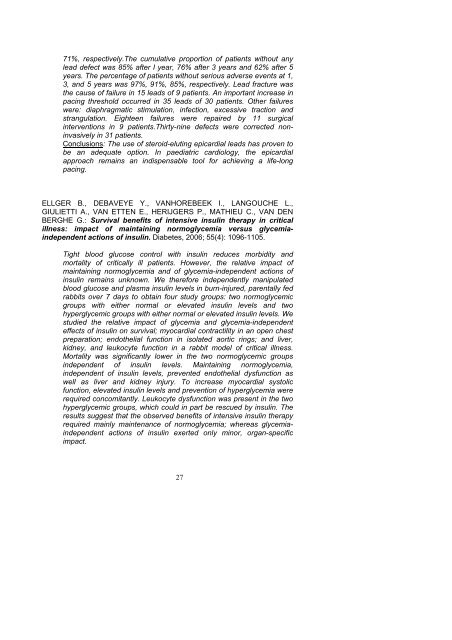2006 - UZ Leuven
2006 - UZ Leuven
2006 - UZ Leuven
You also want an ePaper? Increase the reach of your titles
YUMPU automatically turns print PDFs into web optimized ePapers that Google loves.
71%, respectively.The cumulative proportion of patients without anylead defect was 85% after I year, 76% after 3 years and 62% after 5years. The percentage of patients without serious adverse events at 1,3, and 5 years was 97%, 91%, 85%, respectively. Lead fracture wasthe cause of failure in 15 leads of 9 patients. An important increase inpacing threshold occurred in 35 leads of 30 patients. Other failureswere: diaphragmatic stimulation, infection, excessive traction andstrangulation. Eighteen failures were repaired by 11 surgicalinterventions in 9 patients.Thirty-nine defects were corrected noninvasivelyin 31 patients.Conclusions: The use of steroid-eluting epicardial leads has proven tobe an adequate option. In paediatric cardiology, the epicardialapproach remains an indispensable tool for achieving a life-longpacing.ELLGER B., DEBAVEYE Y., VANHOREBEEK I., LANGOUCHE L.,GIULIETTI A., VAN ETTEN E., HERIJGERS P., MATHIEU C., VAN DENBERGHE G.: Survival benefits of intensive insulin therapy in criticalillness: impact of maintaining normoglycemia versus glycemiaindependentactions of insulin. Diabetes, <strong>2006</strong>; 55(4): 1096-1105.Tight blood glucose control with insulin reduces morbidity andmortality of critically ill patients. However, the relative impact ofmaintaining normoglycemia and of glycemia-independent actions ofinsulin remains unknown. We therefore independently manipulatedblood glucose and plasma insulin levels in burn-injured, parentally fedrabbits over 7 days to obtain four study groups: two normoglycemicgroups with either normal or elevated insulin levels and twohyperglycemic groups with either normal or elevated insulin levels. Westudied the relative impact of glycemia and glycemia-independenteffects of insulin on survival; myocardial contractility in an open chestpreparation; endothelial function in isolated aortic rings; and liver,kidney, and leukocyte function in a rabbit model of critical illness.Mortality was significantly lower in the two normoglycemic groupsindependent of insulin levels. Maintaining normoglycemia,independent of insulin levels, prevented endothelial dysfunction aswell as liver and kidney injury. To increase myocardial systolicfunction, elevated insulin levels and prevention of hyperglycemia wererequired concomitantly. Leukocyte dysfunction was present in the twohyperglycemic groups, which could in part be rescued by insulin. Theresults suggest that the observed benefits of intensive insulin therapyrequired mainly maintenance of normoglycemia; whereas glycemiaindependentactions of insulin exerted only minor, organ-specificimpact.27

















